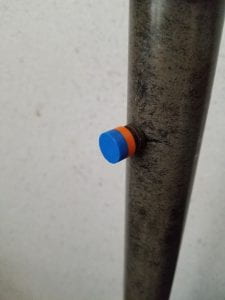
Lamp with 3D printed knob
Here’s a couple of interesting, and very simple, applications of 3D printing that actually saved our campus a significant amount of money. It is important to emphasize up front that we were able to help with these projects because we have colleagues who have gotten the idea that we can fabricate small plastic parts quickly and easily. This awareness of the potential for 3D printing should not be taken lightly and it needs to be nurtured to help to find these types of applications.
Application #1
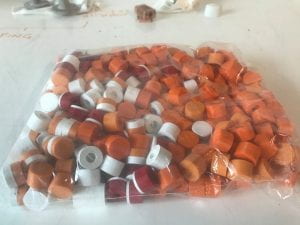
Lamp Knobs
Many of our dorm rooms have a floor standing lamps. These have been around for a while. They still work fine, but the single point of failure is the knob that turns the light on and off and they are broken on most of them. Corinna Coracci, our Director of Residence Life, asked us whether we could make replacement knobs to avoid replacing the lamps. Designing the knob took about 5 minutes (I did it and I’m really slow at CAD). We have been printing them out of ABS on our Stratasys Dimension 1200ES. We print about 100 at a time and have been using up some cartridges that only had one or two in3 of filament left so we end up with some stripy knobs (pictured at right). So far, we have printed about 1200 which has saved the college over $10,000.
Application #2
Our IT folks came to us with these boxes which hold the electronics for the key card readers that have been installed throughout campus. Each box costs about $75 and has boss with a hole in it where the
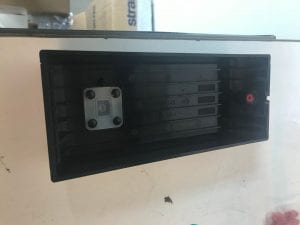
Key Card Reader Box with 3D Printed Insert
box is screwed into the wall. The problem is that the boss breaks off. Again, in about 5 minutes, we designed a 3D printed insert that replaced the boss (it’s the red part shown in the picture). This was also printed out of ABS on our Stratasys Dimension. So far, we have printed 50 of the inserts saving the campus almost $4000.
Application #3
For a lot of educational institutions, part of the planning for the 21-22 academic year was to source clear barriers to provide a physical barrier between faculty/staff/students in a variety of settings to reduce COVID transmission. If anyone was paying attention to plexiglass prices in 2020, it went up pretty dramatically. The campus started trying to source plex shields and found that they were well over $150 each for a relatively small, self-standing shield. We decided to see if we could design and build our own, but to save money and to fabricate them out of more eco-friendly materials than plexiglass. What we ended up designing was essentially a “window frame” constructed by 3D Printed PLA corner braces holding together lengths of 1″x2″ MDF board. The clear plastic is 5 mil PETG left over from our faceshield project. The plastic was held onto the MDF with double-sided carpet tape and staples. We made a free-standing version with 3D printed Hawk Feet and a hanging version with eye hooks screwed into the top. These were also larger than any of the commercially available plex models – our standard size was 48″x40″, but they can me easily modified. We made over 120 of these that were deployed in offices and classrooms. Except for the PETG and staples, everything is biodegradable. We charged the campus $25/each, generating a minimum savings of $15,000.
Of course, we started hearing more recently that the barriers may not be a good idea, particularly in small spaces, because they interfere with ventilation which is needed to sweep out any virus particles. They did seem like a good idea at the time!
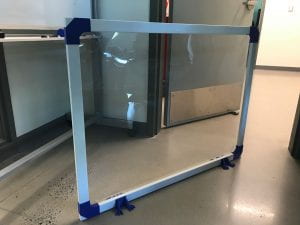
Free standing barrier
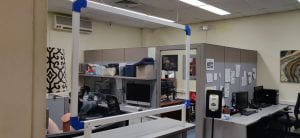
Hanging barrier
